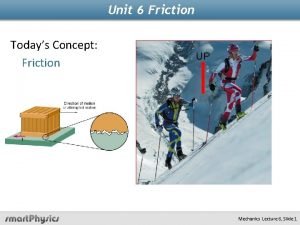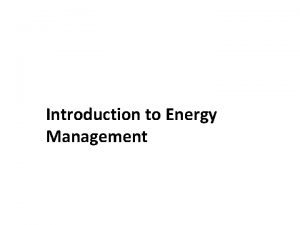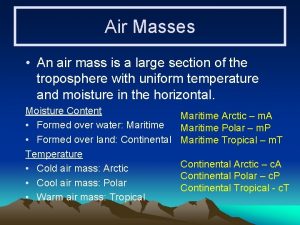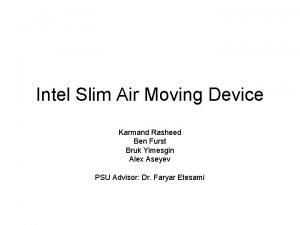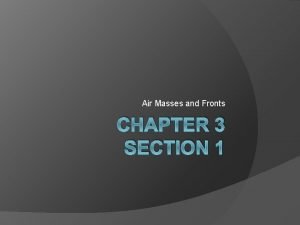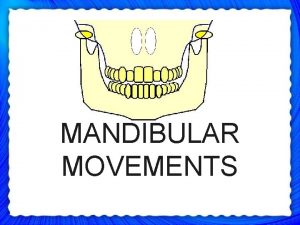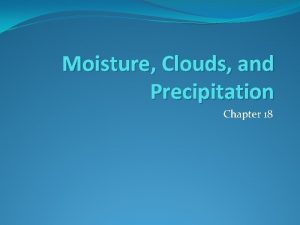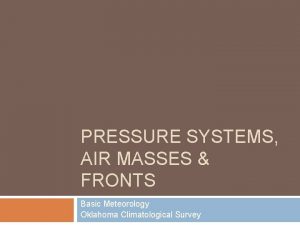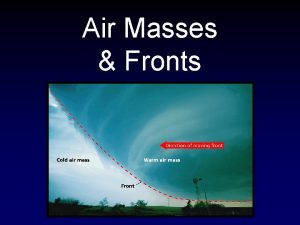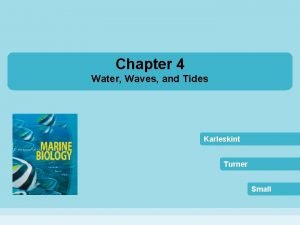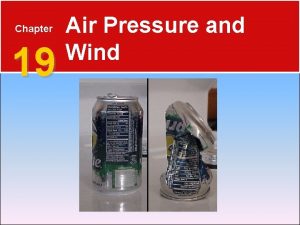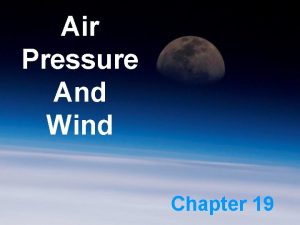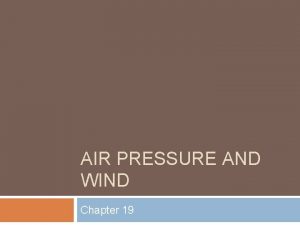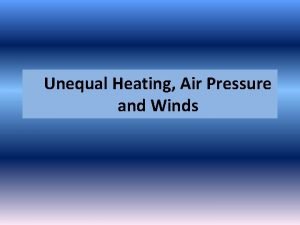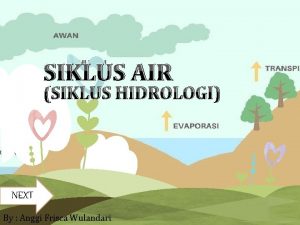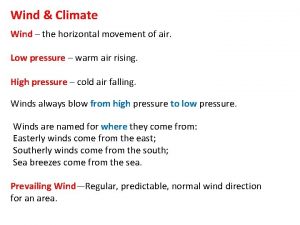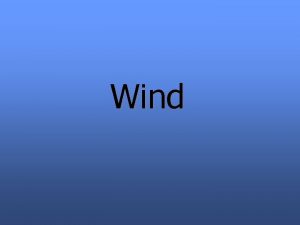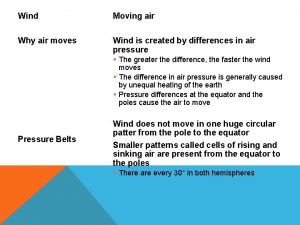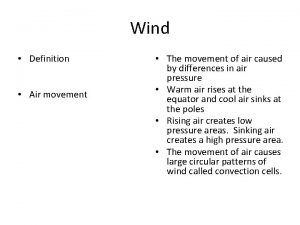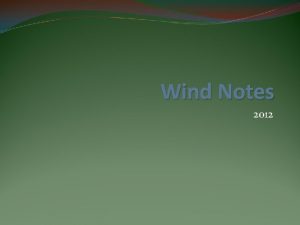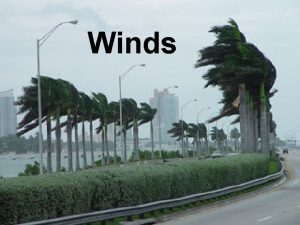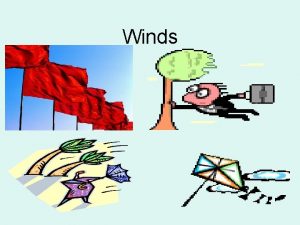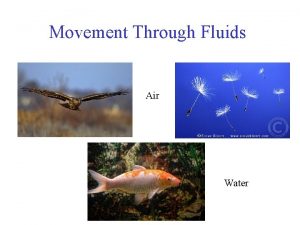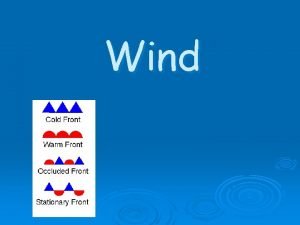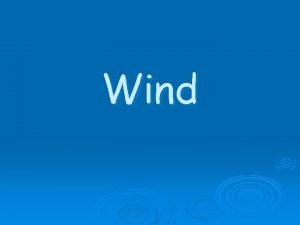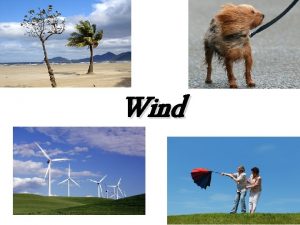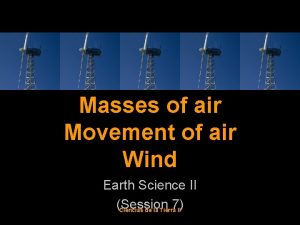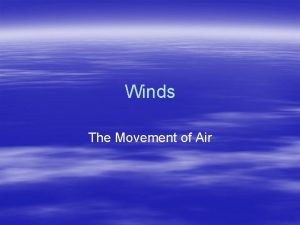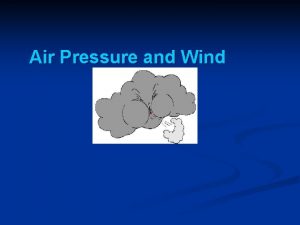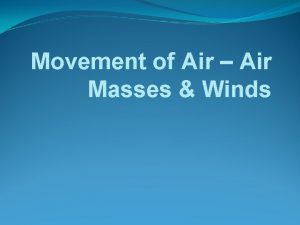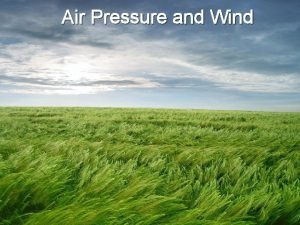WIND What is wind moving air horizontal movement






















- Slides: 22

WIND

What is wind? moving air • horizontal movement of air from an area of high pressure to an area of low pressure • winds can be local or global •

Remember this? Areas of high pressure push towards areas of low pressure.

Do you remember how temperature affects air pressure?

Temperature affects pressure Heat causes molecules to move faster. Moving faster increases the amount of collisions between individual molecules and the relative force of those collisions. More force results in more pressure. Faster moving molecules exert greater pressure on a rigid container. If there is no container, then faster molecules will move apart.

Temperature affects pressure Faster air molecules move apart (expand) and become less dense (more buoyant) A less dense, warmer air mass has lower air pressure A less dense, warmer air mass will rise when buoyed up by a denser air mass A cooler air mass is more dense A cooler air mass will sink What is this process called?

CONVECTION! Convection currents form in the atmosphere because of the unequal heating of Earth’s surface by the sun. When fluids of different densities come in contact, the denser fluid sinks beneath the less dense fluid and the less dense fluid rises, cools, increases in density and sinks…. . round & round

What causes wind? Differences in air pressure cause wind Differences in air pressure are caused by the uneven heating of Earth’s surface because incoming solar radiation concentrates at the equator and not so much at the poles

What causes wind? Air pressure differences cause air to move (wind to blow) from areas of high pressure to areas of low pressure � Humidity affects air pressure, too. Humid air is less dense than dry air. (counterintuitive, but true!) � Winds blow at different altitudes and latitudes � Some winds are local � Some winds are global � Watch this: Bill Nye Wind video clip: http: //youtu. be/u. Bqoh. Ru 2 RRk

Measuring Wind Anemometer (an uh MOM eh ter) is a wind speed measuring device

Wind direction Wind direction tells you where the wind is coming from North wind blows from north to south Southwest wind blows from southwest to northeast Never eat soggy waffles!

Wind-Chill Factor Measures the cooling effect of wind Cooling effect is due to heat loss Wind blowing over skin removes body heat causing heat loss which may be pleasant in summer, but not so much in winter

http: //www. nws. noaa. gov/os/windchill/index. shtml

Coriolis Effect Winds don’t blow straight because of Earth’s rotation affects the motion of air and water. Spinning deflects winds to the right in the Northern Hemisphere and to the left in the Southern Hemisphere Most at poles None at equator

Coriolis Effect video clips: Coriolis Effect Coriolis and other animations, interactives Coriolis Effect Animation

Global Winds Blow steadily from a specific direction Created by uneven heating of Earth’s surfaces Movement of air between equator and poles in giant convection cells Also include areas of decreased wind activity Hot, humid air at equator rises creating low pressure area. . . stops rising when density of hot, humid air mass equals air masses around. . can’t go up because up is less dense, can’t go down because down is more dense, so it goes sideways at higher altitudes. . . towards poles. . as it moves to higher latitudes, air cools, becomes more dense and sinks. . sinks to lower altitudes and begins to move back towards poles. . . higher pressure to lower pressure

Local Winds Blow over short distances Caused by unequal heating in small area Influenced by geography –> shoreline, mountain

Sea and Land Breezes Click here for Sea and Land Breezes Animation

Jet Streams Bands of high-altitude, high-speed winds in upper troposphere/lower stratosphere Blow west to east 200 – 400 km per hour

Jet Streams Shift north & south along wavy paths caused by high-altitude air pressure differences at different latitudes Reason major weather systems move west to east

Jet Stream video clip: http: //youtu. be/Cg. MWwx 7 Cll 4

Ocean Currents are also affected by the Coriolis Force NASA Dynamic Planet NASA Perpetual Oceans
 Horizontal movement of air
Horizontal movement of air Horse latitudes
Horse latitudes Hubungan air dengan tanah
Hubungan air dengan tanah Angular sedimentary rocks
Angular sedimentary rocks A box sits on the horizontal bed of a moving truck
A box sits on the horizontal bed of a moving truck Air moving equipment
Air moving equipment Which major type of air mass is moving into the area?
Which major type of air mass is moving into the area? Faryar etesami
Faryar etesami Which major type of air mass is moving into the area?
Which major type of air mass is moving into the area? Movement area
Movement area Definition of axial movement
Definition of axial movement Steuerbord vor backbord
Steuerbord vor backbord Immediate side shift
Immediate side shift Air that resists vertical movement is said to be
Air that resists vertical movement is said to be Air movement and control association
Air movement and control association Occluded front
Occluded front Cold front air movement
Cold front air movement Vertical air movement
Vertical air movement Chapter 19 air pressure and wind
Chapter 19 air pressure and wind Chapter 19 air pressure and wind
Chapter 19 air pressure and wind Chapter 19 air pressure and wind wordwise answer key
Chapter 19 air pressure and wind wordwise answer key Winds
Winds Air hujan sanggup menjadi air tanah lantaran proses
Air hujan sanggup menjadi air tanah lantaran proses




